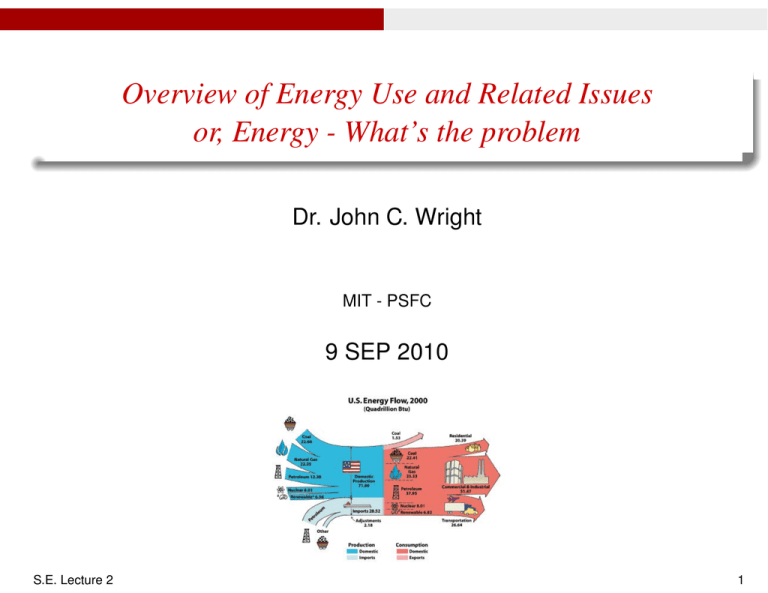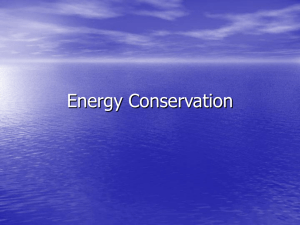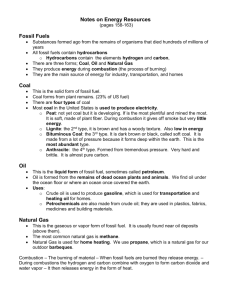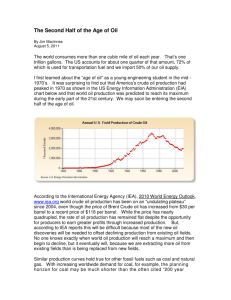Document 13444006
advertisement

Overview of Energy Use and Related Issues or, Energy - What’s the problem Dr. John C. Wright MIT - PSFC 9 SEP 2010 S.E. Lecture 2 1 Introduction W ELL KNOWN ISSUES Energy use is increasing Raw fuel reserves are limited Pressure on standard of living Global warming S.E. Lecture 2 2 Introduction Selecting solutions S OME PROPOSED SOLUTIONS Replace coal with renewables (wind, solar) Sequester CO2 Switch to biofuels Conservation Add heating insulation Bring back nuclear S.E. Lecture 2 3 Introduction Selecting solutions M ORE PROPOSED SOLUTIONS Drive smaller cars Expand use of geothermal Use oil shale and tar sands for gasoline Build smaller houses Increase the efficiency of everything Cars: hybrids, plug-in hybrids, fully electric S.E. Lecture 2 4 Introduction Selecting solutions S TRATEGY A SSESSMENT It’s a hodge-podge Are all problems being addressed? Are alternatives compared by means of a cost-benefit analysis? Are we providing sufficient funds for R&D innovations? Does the media do a good job informing the public? S.E. Lecture 2 5 Introduction Course and this lecture M AIN C OURSE G OALS Put logic and order into the energy situation Develop a comprehensive overview Learn how to measure and evaluate options Arm you with the knowledge to make sensible decisions S.E. Lecture 2 6 Introduction Course and this lecture O UTLINE Energy uses Energy consumption Fuel reserves The greenhouse effect Energy technologies S.E. Lecture 2 7 Energy usage E NERGY S OURCES AND U SES A useful breakdown of energy usage Heating - gas, oil Transportation - oil Electricity - coal, nuclear, gas, hydro Heating - anything will do Transportation - need mobile fuel Electricity - lighting, cooling, industry S.E. Lecture 2 8 Energy usage US E NERGY U SAGE Electricity Energy by Application in 2007 Electricity Transportation Heating 40% 32% Heating 28% Transportation (EIA-DoE 2007) S.E. Lecture 2 9 Energy usage Resource usage breakdowns US O IL U SAGE Transportation vs. heating Heating 31% 69% Transportation S.E. Lecture 2 10 Energy usage Resource usage breakdowns US E LECTRICITY B REAKDOWN How do we obtain electricity? Electricity Breakdown 2007 Coal 49% 4% 6% 22% Gas 19% Other Hydro Nuclear S.E. Lecture 2 11 Energy usage Resource usage breakdowns OTHER Other = 4.1% Oil 1.61% Wood 0.01% Solar 0.36% Geothermal 0.41% 0.78% 0.93% Waste S.E. Lecture 2 Wind 12 Energy usage Resource distribution W ORLD C OAL R ESERVES = 930423 MILLON SHORT TONS [data from doe.eia.gov] Lots of coal in US, Russia, China, India, Australia Data normalized to peak value. S.E. Lecture 2 13 Energy usage Resource distribution W ORLD G AS R ESERVES = 6189 MILLION MILLION CUBIC FEET [data from doe.eia.gov] Gas in Russia Data normalized to peak value. S.E. Lecture 2 14 Energy usage Resource distribution W ORLD O IL R ESERVES = 1277 THOUSAND MILLION BARRELS [data from doe.eia.gov] Oil in Saudi Arabia. Compare barrels, ft3 , tonnes, short tons, Mtoe S.E. Lecture 2 15 Energy usage Supplies W ORLD E NERGY C ONSUMPTION · 104 Oil Natural Gas Nuclear Energy Hydroelectricity Coal Mtoe 1 0.5 2000 1990 1980 1970 Year Growth in energy usage related to increase population and standard of living Note recent reduction in 2008-2009. S.E. Lecture 2 16 Energy usage Supplies H OW LONG WILL THE SUPPLIES LAST ? Oil and natural gas - 50 years Coal - 300 years Oil shale and tar sands - 350 years Nuclear fission Today’s light water reactors - 100 years Future breeders - 10,000 years Nuclear fusion DT reaction - 10,000 years DD reaction ­ ∞ Renewables - ∞ S.E. Lecture 2 17 Energy usage Supplies H OW ABOUT USING H INSTEAD OF NUCLEAR TO REPLACE FOSSIL FUELS ? Hydrogen is not a naturally occurring fuel There are no hydrogen mines It must be manufactured - it’s an energy carrier Basic problems are tough Takes considerable energy to produce hydrogen. Difficult to transport . Expensive to transport. Energy density is low: vs. for gasoline. S.E. Lecture 2 18 Technologies T HE M AJOR T ECHNOLOGIES OF I NTEREST Fossil fuels Nuclear fission Hydroelectric Renewables Wind Solar thermal Solar voltaic Biomass Geothermal How do these work? S.E. Lecture 2 19 Technologies H OW DOES A POWER PLANT WORK ? Steam Furnace Heat exchanger Steam turbine Water Makeup water Electric generator Electricity Exhaust steam Condenser Image by MIT OpenCourseWare. Exhaust steam is waste heat into the environment Heat engine efficiency is given by furnace inlet temperature and exhaust temperature: η = (1 − Te /Ti ) S.E. Lecture 2 20 Technologies R EAL H EAT E NGINES Oil(gasoline) Coal Gas Nuclear Images from Israel Electric Company Archive via Pikiwiki, TTTNIS, Sancio83 on Wikimedia Commons, and Andrew J. Ferguson on Flickr. Power density ~300 W/m2 . Total footprint may be different. S.E. Lecture 2 21 Technologies Fossil fuels F OSSIL F UELS Put the fuel in a tank and light a match All fossil fuels use oxygen to burn All fossil fuels produce large amounts of CO2 All fossil fuels produce some amount of pollution due to impurities Basic chemical reactions: Coal Gas Gasoline S.E. Lecture 2 C + O2 → CO2 + heat CH4 + 2O2 → CO2 + 2H2 O + heat C8 H18 + 12.5O2 → 8CO2 + 9H2 O + heat 22 Technologies Fossil fuels T HE P ROBLEMS WITH F OSSIL F UELS We are running out of gas and oil - US oil production peaked in 1970. Much of the supply is in unstable parts of the world. We have a good amount of coal. All fossil fuels produce large amounts of CO2, which is a greenhouse gas. Carbon sequestration is not yet a proven technology. S.E. Lecture 2 23 Technologies Fossil fuels R EVIEW THE G REENHOUSE E FFECT How do “greenhouse” gasses cause global warming? Radiation from the sun hits the earth Most is in the visible frequency range Some is reflected, most absorbed. Re-radiation rate depends on temperature (∝ T 4 ) At equilibrium the earth reaches a high enough temperature so that Image created by Robert A. Rohde / Global Warming Art. Power in = Power out S.E. Lecture 2 24 Technologies Fossil fuels P OLLUTION Shangai Bombay Courtesy of Michael Golay. Used with permission. S.E. Lecture 2 25 Technologies Nuclear N UCLEAR F UEL More difficult than fossil fuel Natural uranium 99.3%238 U + 0.7%235 U Only 235 U produces energy by fission Complicated enrichment needed for 4% 235 U Place fuel rods in a reactor vessel S.E. Lecture 2 26 Technologies Nuclear N UCLEAR F UEL Containment structure Water vapor Pressurizer Reactor vessel Control rods Reactor core Water coolant (330 ◦ C) Alternator Liquid Condenser Pump Cooling tower Cooling water Water coolantPump (280 ◦ C) Pressurized water (primary loop) S.E. Lecture 2 Turbine Steam generatorVapor (heat change) Pump Water and steam (secondary loop) Water (cooling loop) 27 Technologies Nuclear BASIC N UCLEAR R EACTION After several intermediate steps the key nuclear reaction is n + 235 U → 2 fission products + 2.5n + 6β + 10γ + 10ν + energy A large amount of energy is released This is converted to heat 1 nuclear reaction = 1,000,000 fossil reaction S.E. Lecture 2 28 Technologies Hydro H YDROELECTRIC Put your paddle wheel into flowing water Attach the shaft of the wheel to a generator Voila - electricity Main source of energy is gravity Key power relation is given by: Power =(hydraulic head)(flow rate)(efficiency) =ρgh[J/m3 ] × Q[m3 /s] × η[%] Implied power density is low. Hydraulic head is 0.27 kWh/m3 at 100m. Need large reservoirs to store water (power density ~3 W/m2 ) S.E. Lecture 2 29 Technologies Hydro S CHEMATIC DIAGRAM Image by MIT OpenCourseWare. Adapted from Tennessee Valley Authority. Image by Mikhail Ryazanov on Wikimedia Commons. S.E. Lecture 2 30 Technologies Hydro H YDROELECTRIC P LANT Photo by Lynn Betts, USDA Natural Resources Conservation Service. S.E. Lecture 2 31 Technologies Other W IND P OWER Wind turns the windmill blades Mechanical motion converted to the shaft of a generator, producing electricity Low power density (~2 W/m2 ) Cape Wind - 25 square miles of water Produces 400 MWe peak Produces 130 MWe average S.E. Lecture 2 32 Technologies Other W IND P OWER IN Q UEBEC Photo by André Cotte on Flickr. S.E. Lecture 2 33 Technologies Other S OLAR Peak normal solar irradiance is 1kW/m2 (at surface, 1.366 kW at top of atmosphere, known as the solar constant) The sun’s energy can make electricity There are two ways: Solar thermal Rays are focused Focused rays can heat water Water turns to steam to make electricity Solar voltaic The sunlight impinges on a solar voltaic cell The energy is directly converted into DC electricity S.E. Lecture 2 34 Technologies Other S OLAR E NERGY Photos by Sandia National Labs and Rainer Lippert on Wikimedia Commons. Like wind, the power density is low Peak power produced is about 100 - 200 W/m2 Average power is about 30 - 60 W/m2 25 square miles produces about 100 - 200 MW on average S.E. Lecture 2 35 Technologies Other B IOMASS Burn wood, plants, etc. Burn lot’s of it Huge land area required Potential for new discoveries Photo by Dattodesign on Flickr. S.E. Lecture 2 36 Technologies Other G EOTHERMAL Dig a hole in the ground Keep digging until you reach steam or hot water - steam mixture under pressure This hot fluid is forced to the surface Use it to make steam Use the steam to make electricity Pump the water back into the earth S.E. Lecture 2 Image from EERE. 37 Technologies Other D ISCUSSION Questions? S.E. Lecture 2 38 MIT OpenCourseWare http://ocw.mit.edu 22.081J / 2.650J / 10.291J / 1.818J / 2.65J / 10.391J / 11.371J / 22.811J / ESD.166J Introduction to Sustainable Energy Fall 2010 For information about citing these materials or our Terms of Use, visit: http://ocw.mit.edu/terms.







